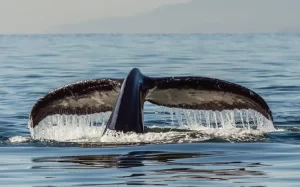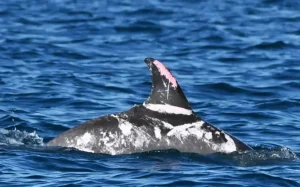Spanning more octaves than a piano, the songs of humpback whales resonate powerfully through the vast ocean, blending with the deep, bass-like sounds of blue and fin whales to form an extraordinary marine symphony. These intricate and beautiful songs are more than just communication; they serve as indicators of environmental changes, as revealed by a new study published in PLOS One.

Tracking Whale Songs Over Time
A six-year research effort in the eastern North Pacific off the coast of California has uncovered a compelling connection between whale song frequency and ecosystem conditions. This biologically rich foraging habitat supports migrating whales that travel long distances to lower-latitude breeding grounds each year. With little to no food intake during migration and breeding, these whales rely on energy reserves built up during their time in these foraging areas.
The study sought to determine if changes in foraging conditions affected the whales’ acoustic behavior. Given that different whale species have distinct diets—blue whales consume only krill, while humpbacks eat both krill and schooling fish such as anchovy—their songs could potentially reveal much about the availability of their preferred prey.
A Symphony of Data Collection
The study utilized a combination of research methods, including deep-sea hydrophone recordings, photo identification, and diet analysis. Scientists at the Monterey Bay Aquarium Research Institute (MBARI) used data from the Monterey Accelerated Research System, a deep-sea observatory, to track the whales’ vocalizations across thousands of square kilometers.
For humpback whales, an extensive photo-identification effort through the Happywhale community science project helped researchers monitor local abundance, migration timing, and regional persistence of individual whales. Other data sources, such as ecosystem assessments and sound propagation models, allowed researchers to build a comprehensive picture of how environmental changes influence whale behavior.
More Food, More Song
The study began in 2015 during a marine heatwave that drastically disrupted the foraging habitat of whales and other marine animals. During this period, all three whale species exhibited reduced singing behavior. As foraging conditions improved over the next two years, whale song activity increased significantly, revealing a close link between singing behavior and food availability.
Notably, the study found that humpback whale song occurrence closely mirrored the dramatic increase in northern anchovy populations—the highest in 50 years. Skin analysis of humpback whales confirmed a dietary shift toward a fish-dominated diet, which likely contributed to their increased vocal activity.
In contrast, blue whales, which rely solely on krill, experienced a decline in song frequency when krill populations diminished. Skin samples indicated that blue whales had to forage over larger geographic areas to meet their dietary needs.
Listening to the Ocean’s Future
This study highlights that whale songs are not just mesmerizing sounds but also crucial ecological indicators. Humpback whales, in particular, appear to be highly resilient, adapting more readily to fluctuations in food availability. Understanding these behavioral patterns can help scientists predict how marine ecosystems and species will respond to long-term environmental changes driven by both natural cycles and human impact.
As climate change continues to reshape ocean ecosystems, interdisciplinary collaboration among researchers will be essential. By listening to the underwater symphony of whales, we can gain deeper insights into their world and better protect these magnificent creatures for future generations.
Summarised by AI – read the full article here >>>>



